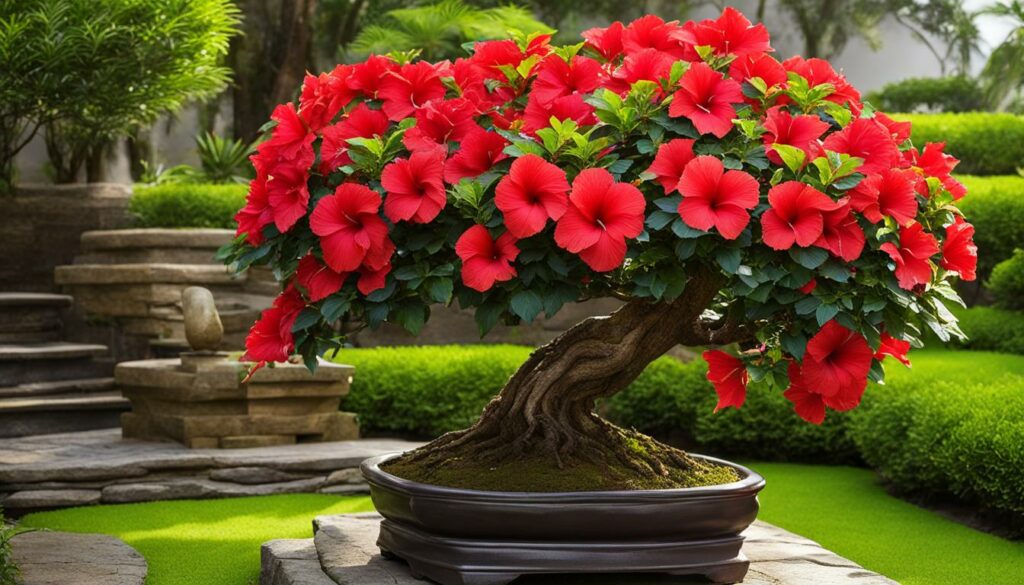If you’re looking for a dazzling display of color and an exotic addition to your bonsai collection, the Tropical Hibiscus bonsai may be just what you need. This flowering bonsai species boasts vibrant blooms in a wide range of shades, from rich oranges and pinks to soft yellows and whites, making it an attractive choice for many bonsai enthusiasts.
Native to tropical regions, the Hibiscus bonsai requires specific care to flourish. However, with proper cultivation techniques, it can thrive both indoors and outdoors, adding a touch of the tropics to any environment. Whether you’re a seasoned bonsai gardener or just starting, the Tropical Hibiscus bonsai is well worth considering.
Key Takeaways
- The Tropical Hibiscus bonsai offers a stunning array of colorful blooms in a range of shades.
- Careful cultivation is required to help this tropical bonsai species thrive both indoors and outdoors.
- Choosing the right pot, watering and fertilizing, pruning and shaping, and ideal environmental conditions are all critical to achieving optimal results.
- Common pests and diseases such as aphids, scales, and fungal infections can pose a threat to the health of your Hibiscus bonsai.
- The vibrant beauty of the Hibiscus bonsai can make it a captivating addition to any bonsai collection.
Understanding the Tropical Hibiscus Bonsai
The Tropical Hibiscus bonsai is a stunning and exotic addition to any bonsai collection. This species originated in Asia and the Pacific Islands and is known for its vibrant, large flowers that bloom in an array of colors, including red, pink, orange, yellow, and white.
When it comes to growth patterns, the Tropical Hibiscus bonsai is a deciduous tree that sheds its leaves in the winter and produces new foliage in the spring. Its trunk and branches are sturdy and durable, making it an excellent choice for shaping and styling.
One unique attribute of the Tropical Hibiscus bonsai is that it can be trained to grow either indoors or outdoors, as it can tolerate both warm and cool temperatures. However, it thrives best in environments where the temperature is consistently warm, between 60-85°F (15-29°C), and with moderate humidity levels.
The Tropical Hibiscus bonsai is particularly popular among bonsai enthusiasts due to its quick growth rate and ability to produce large, vibrant flowers year-round.
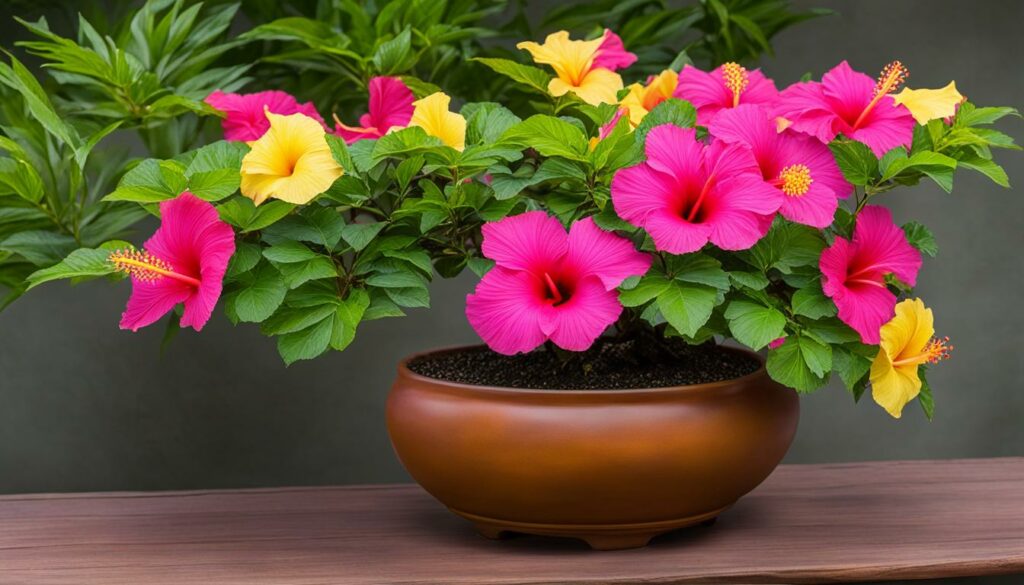
Overall, the Tropical Hibiscus bonsai is a beautiful and rewarding species to cultivate, with its stunning flowers and tolerance for a range of environments making it a unique and versatile addition to any bonsai collection.
Cultivating a Hibiscus Bonsai Tree
To cultivate a stunning Hibiscus bonsai tree, you must follow the right gardening practices. Here are step-by-step instructions for growing this tropical bonsai:
- Choose the right variety
When selecting a Hibiscus bonsai tree, you must consider the variety of Hibiscus that best suits your requirements. Some popular varieties include Hibiscus Rosa-Sinensis, Hibiscus Schizopetalus, and Hibiscus Acetosella.
- Prepare the soil
The soil must be well-draining and rich in nutrients. A mixture of peat moss, perlite, and sand works best. The soil’s pH level should be slightly acidic, ranging between 6.0 and 6.8.
- Watering and fertilizing techniques
Water your Hibiscus bonsai tree adequately and keep the soil evenly moist but not waterlogged. Hibiscus bonsai trees require high levels of nutrients to thrive, so fertilize every two to four weeks during the growing season. Use a balanced fertilizer containing equal amounts of nitrogen, phosphorus, and potassium.
- Pruning and shaping
Prune your Hibiscus bonsai tree to create your desired shape and size. The best time for pruning is in spring, just before the growing season. Pinch back the tips of new growth to encourage the tree to grow bushy and dense.
- Ideal environmental conditions
Hibiscus bonsai trees thrive in warm, humid environments and require plenty of bright sunlight. Keep your Hibiscus bonsai tree in a spot that receives at least six hours of bright, direct sunlight every day. Also, provide adequate humidity by setting your Hibiscus bonsai tree on a tray of pebbles filled with water.
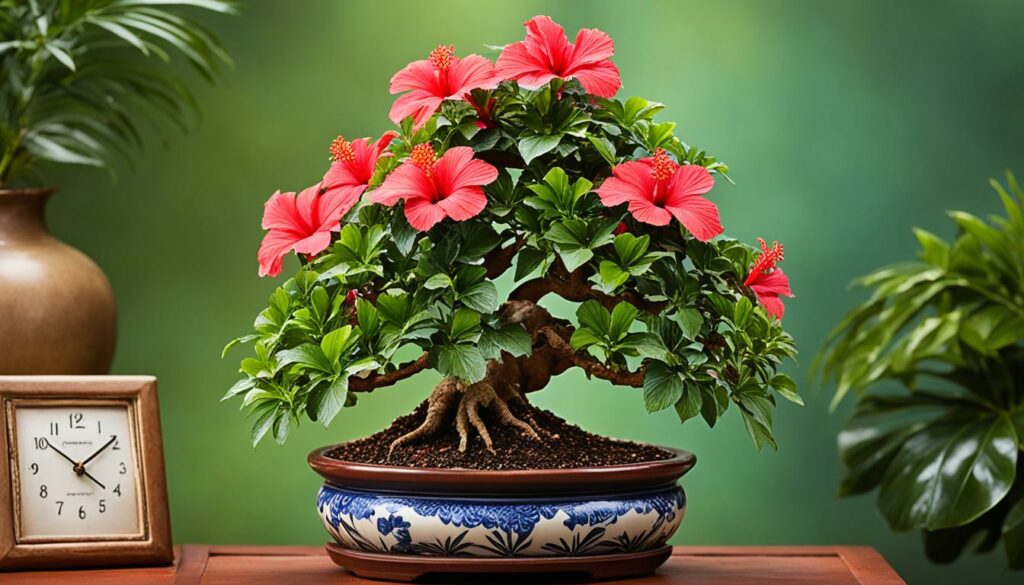
Tip: Keep your Hibiscus bonsai tree away from cold drafts, air conditioning vents, and windows during the winter months.
Choosing the Right Pot for Your Hibiscus Bonsai
Careful consideration should be given to the container you choose for your Hibiscus bonsai. The size, shape, and material of the pot can all impact the health and growth of the tree.
The ideal pot size for a Hibiscus bonsai should be approximately one-third the height of the tree, ensuring that it has enough space for root growth. The depth of the pot should allow for proper drainage, preventing the roots from becoming waterlogged.
| Pot Material | Pros | Cons |
|---|---|---|
| Terracotta | Durable, Allows for Good Airflow | Prone to Cracking, Can Dry Out Quickly |
| Ceramic | Attractive, Retains Moisture Well | Expensive, Can be Heavy |
| Plastic | Lightweight, Inexpensive, Easy to Maintain | Poor Air Circulation, Can Overheat, Susceptible to UV Damage |
When selecting a Hibiscus bonsai pot, consider the style as well. A traditional glazed ceramic pot can complement the tree’s exotic beauty, while a modern-looking planter can create a unique juxtaposition.
Remember to ensure that the pot is equally appropriate for the environment in which it will be placed, such as indoor or outdoor. Also, consider the drainage holes, as improper drainage can lead to root rot and other diseases. Proper pot selection can help your Hibiscus bonsai thrive and add beauty to your collection.
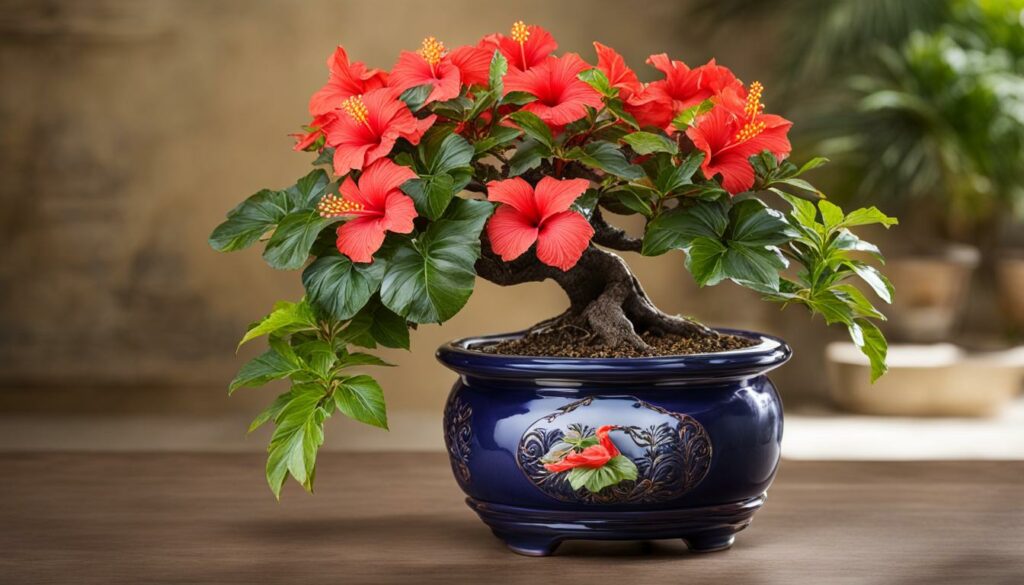
Pruning and Shaping Techniques for Hibiscus Bonsai
To maintain the desired shape and size of your Hibiscus bonsai, pruning and shaping are essential practices that help promote healthy growth and elegant form.
When pruning, it is best to wait until after the flowering season to avoid interfering with the blooming process. Use sharp and clean pruning shears to selectively remove dead or diseased branches, crossing branches, or those that are growing in the wrong direction. This will help improve the appearance of your Hibiscus bonsai and its overall health.
Shaping your Hibiscus bonsai is an art that requires patience and attention to detail. To achieve a specific shape, use wire to gently and gradually bend the branches into the desired position. Be careful not to apply too much pressure, as it may cause damage. Keep the wire in place for a few months until the branches have set in the new position.
To encourage optimal growth, regularly water and fertilize your Hibiscus bonsai according to its species-specific requirements. By following these pruning and shaping techniques, you can ensure that your Hibiscus bonsai remains healthy, vibrant, and visually appealing.
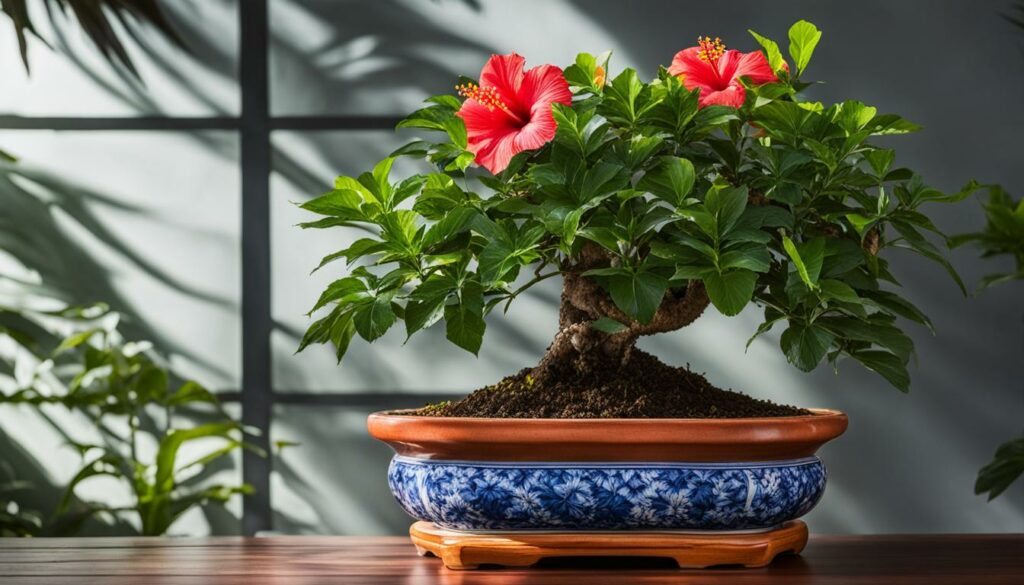
Watering and Fertilizing Your Tropical Hibiscus Bonsai
To keep your Tropical Hibiscus bonsai thriving, proper watering and fertilization is crucial. The frequency of watering your bonsai depends on various factors such as the climate, location, humidity, and soil type. As a general rule of thumb, it is recommended to water your Hibiscus bonsai when the soil appears to be dry on the surface.
Ensure your pot has adequate drainage holes, to prevent accumulation of excess water, that could cause the roots to rot. Do not allow the soil to become too dry or too soaked, as it will stress the plant which can affect its growth and weakening of the plant, or even death.
When it comes to fertilization, a balanced fertilizer with a 10-10-10 or 20-20-20 nutrient content can do wonders for your Tropical Hibiscus bonsai. Fertilize your plant every two weeks with a low-concentration mixture, as too much fertilizer can cause excessive foliage growth, which may result to less flowers.
Consider using liquid fertilizers or slow-release fertilizers to prevent excessive nutrients that can cause damage to the plant. Fertilizing once every two weeks on a regular cycle during growing season from spring to fall is a great way to ensure your Hibiscus bonsai has plenty of nutrients to support healthy growth and flowering.
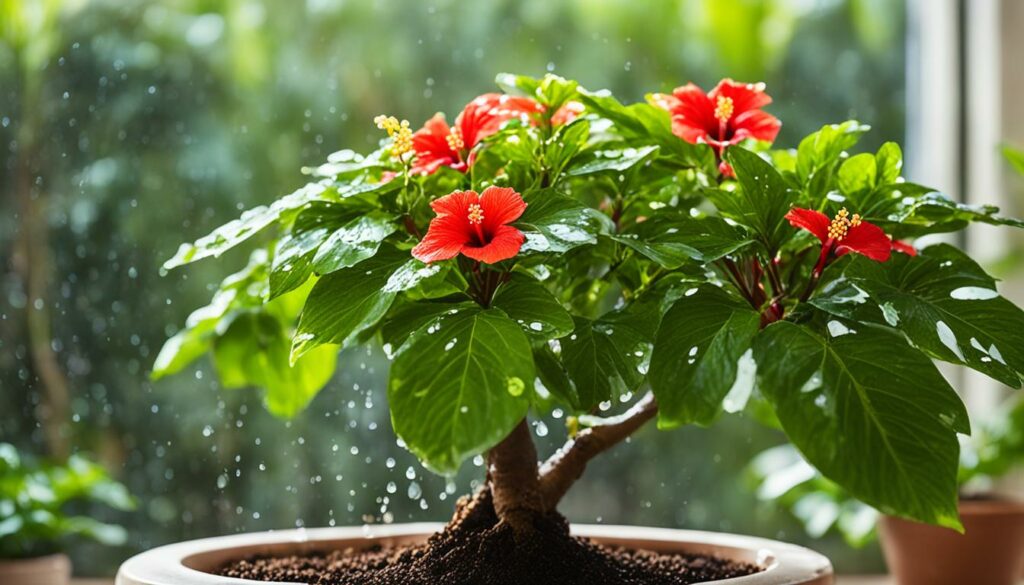
“Remember, watering and fertilizing your bonsai is crucial to keeping it healthy and beautiful. Consistency is key to promoting optimal growth and vibrant flowers.”
Ideal Environmental Conditions for Hibiscus Bonsai
Creating the ideal environment for your Hibiscus bonsai is crucial to its healthy development and longevity. Here are some key factors to consider:
- Temperature: Hibiscus bonsai are tropical plants and require warm temperatures between 60°F and 75°F during the day and no lower than 50°F at night. They cannot tolerate frost or cold drafts, so make sure to keep them in a warm, protected area.
- Sunlight: These bonsai trees need plenty of bright, indirect light to thrive. However, direct sunlight can scorch their leaves, so it’s best to provide shade during the hottest part of the day. A south-facing window with a sheer curtain is ideal.
- Humidity: Hibiscus bonsai prefer a higher humidity level between 50% and 70%. You can increase humidity by placing a tray of water near the bonsai or using a humidifier. Misting the leaves also helps to keep them healthy and shiny.
- Protection from extreme weather: Protect your Hibiscus bonsai from strong winds, heavy rain, and extreme heat or cold. This tropical bonsai species is sensitive to sudden changes in temperature or humidity levels, so make sure to acclimate it gradually to new environments.
Tip: Remember to monitor the temperature, light, and humidity levels regularly to ensure the best growing conditions for your Hibiscus bonsai.
Common Pests and Diseases of Hibiscus Bonsai
Hibiscus bonsai is a hardy plant that can thrive with proper care and maintenance. However, as with any plant, there are potential pests and diseases that you should be aware of to keep your Hibiscus bonsai healthy. Here are some common problems to watch out for:
Aphids
Aphids are small, soft-bodied insects that can infest your Hibiscus bonsai. They feed on the sap of the plant and can cause damage to leaves and buds. To prevent aphids, spray your Hibiscus bonsai with a solution of water and neem oil or insecticidal soap. If you already have an aphid infestation, you can use a strong jet of water to blast them off the plant, or use a chemical pesticide as a last resort.
Scales
Scales are another common pest that can affect your Hibiscus bonsai. They appear as small, flat brown or yellow bumps on the leaves, stems, and branches of the plant. They can also secrete a sticky substance that attracts other insects and promotes the growth of mold. To eliminate scales, prune and dispose of any infected plant parts, and spray with insecticidal soap or horticultural oil.
Fungal Infections
Fungal infections can occur in Hibiscus bonsai due to poor drainage or over-watering. Symptoms include discolored or wilting leaves, mold growth, and root rot. To prevent fungal infections, ensure proper drainage and refrain from over-watering your Hibiscus bonsai. If you suspect a fungal infection, remove any infected plant parts and treat with a fungicide.
“We provide guidance on prevention, early detection, and treatment options.”
By keeping an eye out for these common pests and diseases, you can protect your Hibiscus bonsai and ensure it stays healthy and beautiful for years to come.
Showcasing the Beauty of the Hibiscus Bonsai
As you’ve learned, the Hibiscus bonsai is a gorgeous and vibrant addition to any bonsai collection. Its stunning flowers and unique foliage embody the essence of the tropics, making it a popular choice for bonsai enthusiasts. With proper care and maintenance, your Hibiscus bonsai can flourish and showcase its beauty for years to come.
One of the most striking features of the Hibiscus bonsai is its impressive range of flower colors. From brilliant reds and pinks to soft yellows and whites, the Hibiscus bonsai showcases a spectacular display of hues. Its flowers are large and elegant, resembling delicate tissue paper and adding a touch of elegance to any setting.
The Hibiscus bonsai’s foliage is equally enchanting, with lush green leaves that provide a stunning contrast to the vibrant flowers. Its leaves are arranged in an alternately symmetrical pattern and are generally ovate or lanceolate in shape.
Whether your Hibiscus bonsai is blooming or not, it is a beautiful addition to your bonsai collection. Its tropical allure and striking aesthetic make it a favorite among enthusiasts. With proper care, your Hibiscus bonsai can thrive and continue to showcase its beauty as a flowering and tropical bonsai species.
Overall, the Hibiscus bonsai is a stunning and captivating bonsai tree species that offers a burst of color and beauty to any space. With its vibrant flowers and unique foliage, it is a testament to the art of bonsai cultivation and the natural beauty of the tropics.
FAQ
What is a Tropical Hibiscus bonsai?
A Tropical Hibiscus bonsai is a miniature version of the tropical Hibiscus plant that has been trained and shaped in the art of bonsai. It is known for its vibrant and showy flowers, which make it a beautiful addition to any bonsai collection.
How do I cultivate a Hibiscus bonsai tree?
To cultivate a Hibiscus bonsai tree, start by selecting the right variety and preparing the appropriate soil mixture. Provide ample sunlight, water regularly, and fertilize with a balanced bonsai fertilizer. Prune and shape the branches to create the desired form, and maintain proper environmental conditions.
What pot should I use for my Hibiscus bonsai?
When choosing a pot for your Hibiscus bonsai, consider using a shallow and wide container that allows for proper drainage. Ceramic or clay pots are ideal choices as they provide good stability and breathability for the roots. Make sure the pot size is proportionate to the tree’s size and growth stage.
How often should I prune and shape my Hibiscus bonsai?
Pruning and shaping your Hibiscus bonsai should be done regularly to maintain its desired form and promote healthy growth. Aim to prune during the tree’s dormant period, after flowering. Pinching off new growth tips and thinning out overcrowded branches can also be done throughout the year.
How should I water and fertilize my Tropical Hibiscus bonsai?
Water your Tropical Hibiscus bonsai deeply whenever the top inch of soil feels dry. Ensure the pot has good drainage to prevent waterlogging. Fertilize every two weeks during the growing season with a balanced liquid bonsai fertilizer. Adjust the frequency and strength based on the tree’s response.
What are the ideal environmental conditions for a Hibiscus bonsai?
Hibiscus bonsai thrives in warm and humid conditions. It requires a minimum temperature of 60°F (15°C) and prefers temperatures between 70-85°F (21-29°C). Provide ample sunlight, preferably in the morning and afternoon, and protect the tree from frost and extreme weather conditions.
What are common pests and diseases of Hibiscus bonsai?
Common pests that can affect Hibiscus bonsai include aphids, scales, mealybugs, and spider mites. Watch out for symptoms like yellowing leaves, sticky residue, or visible pests on the tree. Fungal diseases such as powdery mildew and root rot can also occur. Proper care, regular inspections, and prompt treatment can help prevent and manage these issues.
How can I showcase the beauty of my Hibiscus bonsai?
To showcase the beauty of your Hibiscus bonsai, place it in a prominent location where the vibrant flowers and unique foliage can be admired. Consider displaying it on a bonsai stand or rotating it periodically to showcase different angles. Regular grooming and maintenance will enhance its overall appearance.
